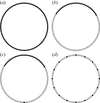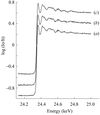issue contents
July 2007 issue

Cover illustration: Synchronization of laser and X-ray pulses at beamline NW14A of the Photon Factory Advanced Ring (see Nozawa et al., pages 313-319). The timing control is based on the RF master clock that drives a single electron bunch in the ring. An X-ray chopper is phase-locked at 945 Hz and isolates 945 Hz X-ray pulses from the X-ray pulse train at 794 kHz. The mode-locked Ti:sapphire laser is operated as the seeding laser and is guided to the regenerative amplifier operated at 945 Hz. Then, the 100 ps X-ray and the 150 fs laser pulses are synchronized at 945 Hz. The two graphs show the photo-induced changes of diffraction intensity of TTF-CA crystal and the Ni-K near-edge spectral changes associated with the photoreaction of NiTPP(Pip)2; data were obtained by time-resolved diffraction and XAFS measurements at NW14A.
facility information
research papers
 access
access access
accessaddenda and errata

current events



 journal menu
journal menu



































